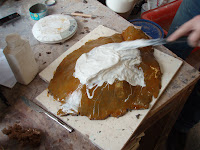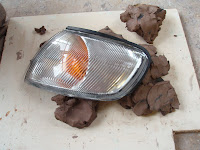
It has been exciting, interesting, hard in places and extremely satisfying making molds of my headlight to fossilise it in different ways. But what has been the cost to me to experience such riches??
Petrol to pick up light - £3
Silicone rubber, Resin and general nik-naks for mold - £40
Wet 'n' Dry sandpaper - £4.38
Print - £6
Frame & Glass - £2!!
Chocolate biscuits! - £1.49
Grand Total: £56.87
FREE STUFF!
Plaster Cast
Polyresin
Teaching and coaching - care of Dave (the master) Taylor!
Patience!

















